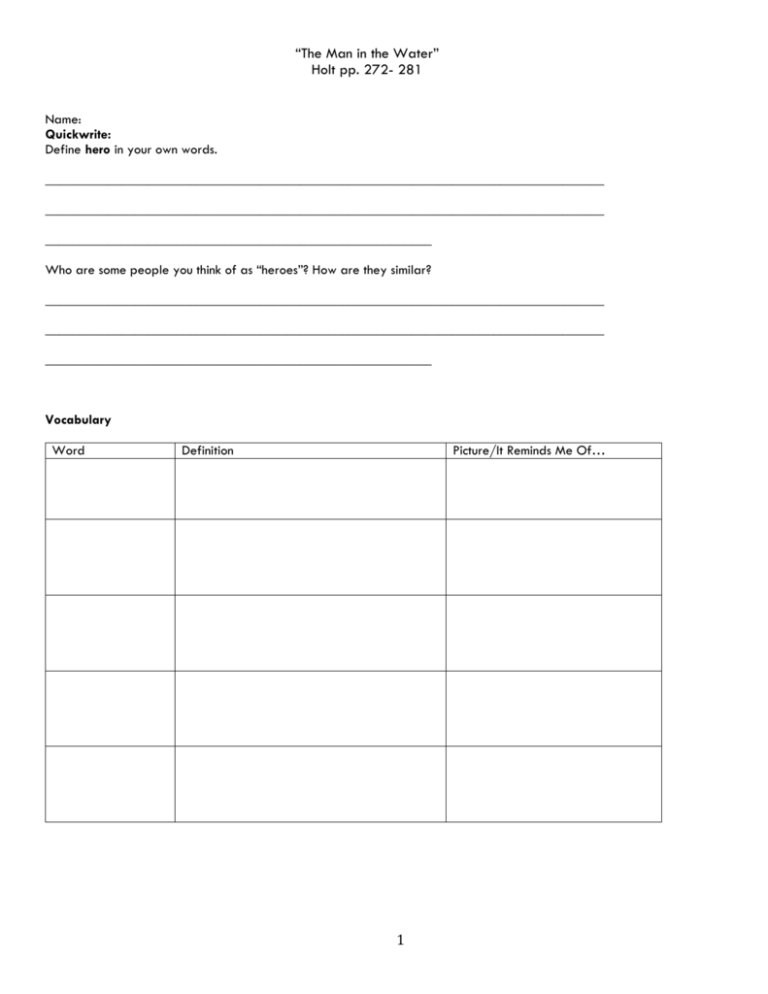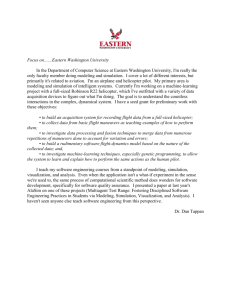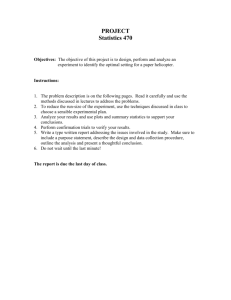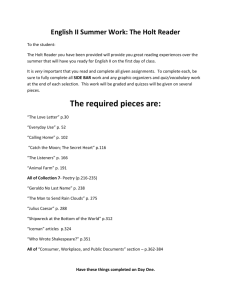“The Man in the Water” Holt pp. 272
advertisement

“The Man in the Water” Holt pp. 272- 281 Name: Quickwrite: Define hero in your own words. _________________________________________________________________________________ _________________________________________________________________________________ ________________________________________________________ Who are some people you think of as “heroes”? How are they similar? _________________________________________________________________________________ _________________________________________________________________________________ ________________________________________________________ Vocabulary Word Definition Picture/It Reminds Me Of… 1 “The Man in the Water” Holt pp. 272- 281 Background Information on “The Man in the Water” This essay, “The Man in the Water” was originally published in TIME magazine in 1982. Knowing its original source, what do you think the author’s purpose was in writing this? Explain. _____________________________________________________________________________________________ _____________________________________________________________________________________________ __________________________________________________________________________ Directions: Read the following background information on the Air Florida Flight 90 disaster. Then answer the questions that follow and make a prediction about what the essay might be about. “Air Florida Flight 90” Air Florida Flight 90 was a scheduled U.S. domestic passenger flight from Washington National Airport in Arlington County, Virginia, to Fort Lauderdale – Hollywood International Airport in Fort Lauderdale, Florida, with a stopover at Tampa International Airport in Tampa, Florida. On January 13, 1982, the Boeing 737-200 flying Flight 90 crashed into the 14th Street Bridge over the Potomac River, killing all but four passengers and one flight attendant. The aircraft was carrying 74 passengers and five crewmembers when it crashed during the failed takeoff attempt. The aircraft struck the 14th Street Bridge, which carries Interstate 395 between Washington, D.C. and Arlington County. It crushed seven occupied vehicles on the bridge and destroyed 97 feet of guard rail before it plunged through the ice into the Potomac River. The crash occurred less than two miles from the White House and within view of both the Jefferson Memorial and The Pentagon. The accident killed 78 people, including four motorists on the 14th Street Bridge. The survivors were rescued from the icy river by civilians ( civilians= every day people like you) and professionals. President Ronald Reagan commended these acts during his State of the Union speech a few days later. The National Transportation Safety Board (NTSB) determined that the cause of the accident was pilot error. The pilots failed to switch on the engines' internal ice protection systems, used reverse thrust in a snowstorm prior to takeoff, and failed to abort the takeoff even after detecting a power problem while taxiing and visually identifying ice and snow buildup on the wings. 1. Describe what happened on January 13, 1982. 2. How many people died because of the crash? 3. How many people survived the crash? 4. If you were a civilian who witnessed a crash like Air Florida Flight 90, would you attempt to save the people in the water? Why or why not? Explain your answer. 2 “The Man in the Water” Holt pp. 272- 281 5. Who was responsible for the flight crash? Explain. 6. Where did the crash occur? 7. If the pilots had survived the crash, do you think they should be held accountable for their errors? Why or why not? *Prediction about the selection “The Man in the Water” Reading Guide: p.272 Holt 1. Examine the photograph on 273. Describe the scene. What mood does the picture create? What emotions does it evoke? Write your responses below. 2. What is ironic or unexpected about a plane named “Air Florida” crashing in the frozen water of the Potomac? Explain. 3. According to the author of the article, how many “acknowledged” or recognized heroes were there in the Flight 90 accident. 4. Who is Lenny Skutnik and what did he do? 5. Describe some physical traits of the “man in the water”. 3 “The Man in the Water” Holt pp. 272- 281 6. What heroic act did the “man in the water” do? 7. Do you agree with the author Roger Rosenblatt’s statement that “no man is ordinary”? Why or why not? Explain. 8. In what way was the “man in the water” powerless? What was he powerless against? Explain. 9. What was the man in the water’s power according to the author? 10. CRQ: What is your reaction to the man in the water’s actions? Would you make the same decisions he made? Why or why not? Explain. _____________________________________________________________________________________________ _____________________________________________________________________________________________ _____________________________________________________________________________________________ _____________________________________________________________________________________________ _____________________________________________________________________________________________ _____________________________________________________________________________________________ ____________________________________________________________________________________________ 4 “The Man in the Water” Holt pp. 272- 281 Meet the Writer p.277 – Holt Directions: Read the “Meet the Writer” section of 277. Write 6 facts you learned about Roger Rosenblatt. Write a reaction -- make an inference, ask a question, or make a connection – for each fact you find. An example is provided for you below FACTS about ROGER ROSENBLATT MY Reactions Example: He began writing at the young age of 7. Some people are born with a gift. I think certain writers have innate, natural talents like the ability to dance, play an instrument, or sing. 1. 5 “The Man in the Water” Holt pp. 272- 281 Air Florida Flight 90 On January 13, 1982, during an extraordinary period of freezing weather, Air Florida Flight 90 took off from nearby Washington National Airport, failed to gain altitude, and crashed into the 14th Street Bridge, where it hit six cars and a truck on the bridge, killing four motorists. After the devastating crash on the bridge, the plane then continued forward and plunged into the freezing Potomac River. Soon only the tail section which had broken off remained afloat. Only six of the airliner's 79 occupants (74 passengers and 5 crew members) survived the initial crash and were able to escape the sinking plane in the middle of the ice-choked river. News cameramen watched helplessly from the bridge, recording the disaster for the rest of the world to see. There appeared to be no way to reach the survivors in the water. Bystanders helped as fellow passerby Roger Olian with a makeshift rope began an attempt to rescue them. Then, hope arrived at approximately 4:20 p.m. EST when Eagle 1, a United States Park Police helicopter based at Anacostia Park in Washington DC and manned by pilot Donald W. Usher and paramedic Melvin E. (Gene) Windsor, arrived and assisted with the rescue operation at great risk to themselves. At one point in the operation the helicopter was so close to the ice-clogged river that the skids went beneath the surface of the water. According to the other five survivors, one passenger was pinned to the fuselage of the plane, but continued to help the others reach the rescue ropes being dropped by the hovering helicopter, repeatedly passing the line to others instead of using it himself. After lifting and towing two badly injured passengers to shore one at a time, an attempt was made to use two lines to haul three more, but as the tow to shore was underway, two of the three fell back into the icy water. As fatigue set in, one of the survivors was too weak to grab the line again, so another bystander, government office assistant Lenny Skutnik, stripped off his coat and boots, and in short sleeves, dived into the icy water and swam out to assist her. The helicopter then proceeded to where the other had fallen. Paramedic Gene Windsor, standing on the right skid of the helicopter, and without a safety harness, was able to lift a female victim out of the icy water by her clothing and up onto the helicopter skid, resting her on his boot. When the additional weight of the victim transferred onto the aircraft, the skids on the helicopter were seen to submerge into the icy water. Pilot Don Usher quickly corrected by adding more lift and then, with Paramedic Windsor holding the victim by the clothing, hovered the aircraft over to rescuers on the shore. While the other five were being taken to shore by the helicopter, the tail section of the wrecked Boeing 737 shifted and sank further into the water, dragging Arland D. Williams Jr. under the water with it. The next day, the Washington Post described his heroism: He was about 50 years old, one of half a dozen survivors clinging to twisted wreckage bobbing in the icy Potomac when the first helicopter arrived. To the copter's two-man Park Police crew he seemed the most alert. Life vests were dropped, then a flotation ball. The man passed them to the others. On two occasions, the crew recalled last night, he handed away a life line from the hovering machine that could have dragged him to safety. The helicopter crew – who rescued five people, the only persons who survived from the jetliner – lifted a woman to the riverbank, then dragged three more persons across the ice to safety. Then the life line saved a woman who was trying to swim away from the sinking wreckage, and the helicopter pilot, Donald W. Usher, returned to the scene, but the man was gone. ANTICIPATION GUIDE Directions: Read each of the following statements and decide whether you agree or disagree. Write an A on the line if you agree. Write a D on the line if you disagree. Explain your opinion on the lines provided. _______1. People should only worry about themselves. 6 “The Man in the Water” Holt pp. 272- 281 _____________________________________________________________________________________________ _____________________________________________________________________________________________ _______2. When someone is hurt or in trouble, it is my duty to help them. _____________________________________________________________________________________________ _____________________________________________________________________________________________ _____________________________________________________________________________________________ _______3. If everyone minded their own business, the world be a better place. _____________________________________________________________________________________________ _____________________________________________________________________________________________ _____________________________________________________________________________________________ _______4. If everyone was more helpful to one another, the world would be a better place. _____________________________________________________________________________________________ _____________________________________________________________________________________________ _____________________________________________________________________________________________ _______5. People are naturally competitive. _____________________________________________________________________________________________ _____________________________________________________________________________________________ _______6. Competition between people is a good thing. _____________________________________________________________________________________________ _____________________________________________________________________________________________ 7







